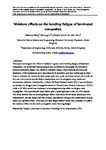Moisture effects on the bending fatigue of laminated composites
| dc.contributor.author | Meng,, M | |
| dc.contributor.author | Le,, H | |
| dc.contributor.author | Grove,, S | |
| dc.contributor.author | Rizvi,, MJ | |
| dc.date.accessioned | 2016-08-05T09:39:19Z | |
| dc.date.issued | 2016-10-15 | |
| dc.identifier.issn | 0263-8223 | |
| dc.identifier.issn | 1879-1085 | |
| dc.identifier.uri | http://hdl.handle.net/10026.1/5191 | |
| dc.description.abstract |
This paper investigated the effect of moisture ingress on the bending fatigue of laminated composites. An accelerated testing method was developed to investigate the correlation between composite fatigue and moisture diffusion effects. Unidirectional and cross-ply laminated CFRP composites were manufactured in autoclave, and then submerged in both fresh and seawater for various periods until moisture saturation. Quasi-static and cyclic tests were carried out in both air and wet environment, and the failure mechanisms were investigated using visual and microscopic methods. Additionally, a robust 2D Finite Element model (FEA) was developed to simulate the fatigue crack propagation based on virtual crack closure technique (VCCT), while a 3D FEA model was developed to investigate the edge effect on fatigue crack propagation. The experimental observations gave a good agreement with the FEA models. The study showed that the bending fatigue failure was due to the so-called buckling-driven delamination, and the fatigue life was reduced significantly owing to the combination of edge effect and capillary effect. The fatigue test indicated that the fatigue resistance was degraded one stress level due to the water ingress, e.g. from 80% ultimate flexural strength (UFS) to 65% UFS. Therefore, a 4-step fatigue failure theory was proposed to explain the moisture effects on the crack propagation under bending fatigue. | |
| dc.format.extent | 49-60 | |
| dc.language | en | |
| dc.language.iso | en | |
| dc.publisher | Elsevier Ltd. | |
| dc.subject | Fatigue | |
| dc.subject | Laminated composites | |
| dc.subject | Buckling-driven delamination | |
| dc.subject | FEA | |
| dc.title | Moisture effects on the bending fatigue of laminated composites | |
| dc.type | journal-article | |
| dc.type | Article | |
| plymouth.author-url | http://www.sciencedirect.com/science/article/pii/S0263822316310807 | |
| plymouth.issue | 0 | |
| plymouth.volume | 154 | |
| plymouth.publisher-url | http://www.sciencedirect.com/science/article/pii/S0263822316310807 | |
| plymouth.publication-status | Published | |
| plymouth.journal | Composite Structures | |
| dc.identifier.doi | 10.1016/j.compstruct.2016.06.078 | |
| plymouth.organisational-group | /Plymouth | |
| plymouth.organisational-group | /Plymouth/Faculty of Science and Engineering | |
| plymouth.organisational-group | /Plymouth/Faculty of Science and Engineering/School of Engineering, Computing and Mathematics | |
| plymouth.organisational-group | /Plymouth/REF 2021 Researchers by UoA | |
| plymouth.organisational-group | /Plymouth/REF 2021 Researchers by UoA/UoA12 Engineering | |
| plymouth.organisational-group | /Plymouth/Users by role | |
| plymouth.organisational-group | /Plymouth/Users by role/Academics | |
| dcterms.dateAccepted | 2016-06-30 | |
| dc.rights.embargodate | 2017-7-19 | |
| dc.identifier.eissn | 1879-1085 | |
| dc.rights.embargoperiod | 12 months | |
| rioxxterms.versionofrecord | 10.1016/j.compstruct.2016.06.078 | |
| rioxxterms.licenseref.uri | http://www.rioxx.net/licenses/under-embargo-all-rights-reserved | |
| rioxxterms.licenseref.startdate | 2016-10-15 | |
| rioxxterms.type | Journal Article/Review |


